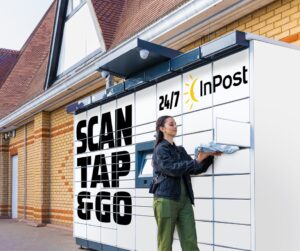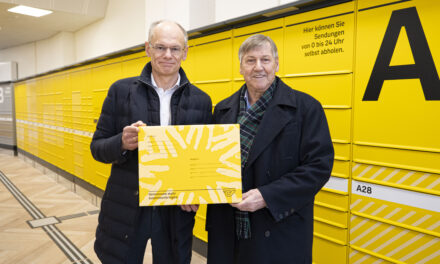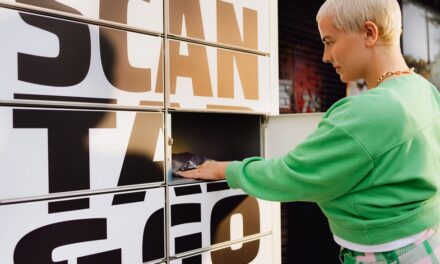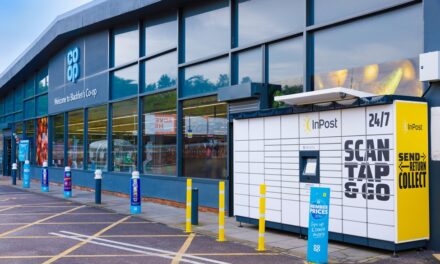
Making delivery cleaner, greener and more convenient

Post & Parcel spoke to Neil Kuschel, UK CEO of InPost, about his plans to build on InPost’s success and roll out 10’s of 1000’s of lockers across the country, making parcel lockers a ubiquitous feature of everyday life.
Firstly congratulations – InPost’s Q1 results were fantastic!
Thank you! It is really exciting that UK consumers are starting to embrace parcel lockers. A couple of years ago there was a lot of talk about whether UK consumers would ever use parcel lockers. But as you can see the parcel volumes we are handling have more than doubled to 46 million!
Why do you think the UK has suddenly cottoned on to parcel lockers?
Our Retail Economics report shows that millennials and Gen Z are really starting to embrace lockers and that’s what’s driving the change. And that gives me confidence that we’re only really at the start of the journey. Our Q1 results show that our locker network has expanded by 59% YOY to over 8,460 OOH points in response to this demand, and there’s huge scope for further growth. It feels like the inflection point is coming now.
How has the economic climate played a part in this change?
The economic environment is tough but the younger generation are still buying stuff -they have just changed their buying habits. For example, there is a massive rise in the use of low cost online brands like Shein and Temu and the people buying from these brands often live in flats in higher density areas and prefer to collect and return items using lockers. There is also a big growth in the preloved/ reuse market often used by people working from home. Therefore, the convenience that lockers give consumers over home delivery is making them more attractive.
Can you describe the UK’s approach to home delivery?
There’s a fixation in the UK with delivery to your home address. Amazon has been a massive driver for delivering e-commerce products next / same day – people sign up for free home delivery and use it for everything.
The UK is a little bit different from the rest of Europe, in that the amount of parcels delivered out of home is only around 5% whereas in Europe it is around 15%.
As part of my induction with InPost in Poland I went out with a courier for the day and I saw first hand how efficient parcel lockers were. I began to question why on earth are we obsessed with delivering to door in the UK? What InPost is doing is absolutely the right direction.
Is the out of home market growing in the UK?
Yes, the UK is now on track to get to 15% of parcels delivered out of home. And the part that excites me the most is that InPost can be the disruptive driver of that movement. We can also help change the way that the UK consumer makes returns. InPost’s return solution is so easy to use and so convenient more and more people are starting to use it.
How do you plan to encourage more age groups to use parcel lockers?
We haven’t gone out to attract a specific audience, but the convenience and the flexibility of lockers resonates well with the Gen Z /Millennial generation. As more retailers use InPost as a return solution it will naturally start being used by other age ranges too.
What are the key obstacles to locker use?
One of the biggest reasons that people don’t use lockers is lack of awareness. Our lockers started out geared towards people who bought and sold on preloved websites and now they are being used as a returns solution – we now need to create awareness of how people can use them as an alternative to home delivery.
How will you drive awareness of InPost parcel lockers?
We will start to roll out our next product which will allow consumers buying from retailers to select an InPost Locker at checkout. This will really start to drive volumes and also awareness.
What did InPost’s Retail Economics report reveal about the benefits of using parcel lockers?
The retail report showed that customers liked the certainty of knowing where and when an item is going to arrive and choosing a convenient location to pick it up. When you deliver to a parcel locker you are in control.
A third of people surveyed experienced one or all of these issues with home delivery – receiving items which were damaged by rain, items left with a neighbour going missing or items being taken elsewhere if the customer isn’t in. All these things lead to dissatisfaction.
How are you using the price to attract customers?
The productivity of a parcel locker is insanely better than home delivery so we can pass that advantage onto the consumer.
An average locker will have around 80 compartments and those compartments can be emptied twice a day. So, a bank of lockers can handle around 150 parcels in a day.
If you compare this to home delivery, 10 x more parcels can be delivered by a courier to a parcel locker than to a home address at the same time.
How can InPost help smaller retailers be more competitive?
InPost has the ability to help level the playing field. At the moment for the majority of the year there’s more capacity than volume. And then there are two months of the year during peak, where there’s more volume than capacity and all the operators are fighting for the same volume, which leads to inequity. The big retailers, who have high volumes can demand cheap rates from the carriers whereas the smaller retailers can’t compete at checkout when it comes to shipping costs as they end up charging 3-5 pounds for postage while bigger companies offer free postage. We can help change this dynamic by giving smaller retailers a way to offer cost-effective, convenient shipping.
Tell me about the sustainability benefits of using parcel lockers?
Parcel lockers are naturally green and delivering to a parcel locker rather than individual houses is genuinely the best thing for the environment and will take a huge number of vehicles off the road. It is not greenwashing.
However we still have work to do to become carbon neutral, starting with finding the right electric vehicle to provide our services. So we’re on a journey – we aren’t there yet but we will be.
Do you think people understand how green parcel lockers are?
In our report, sustainability is actually the last reason people choose to explain why they are using parcel lockers. But this is okay, because it means that people are using them because they are efficient. However, although it may be of lesser importance than convenience for example, the results show that sustainability is still a key factor for choosing lockers. So, retailers have the opportunity to capitalise on both of these trends by ensuring the convenience of the ecommerce experience is matched by the efficiency and sustainability of delivery.
In Poland they’ve just launched green top lockers where operators are growing grass and flowers on top of the lockers. So lockers are being used as a way to bring more nature into urban areas – this is an idea I really like and aspire to bring to the UK too.
How do you encourage people to use parcel lockers sustainably and not pick up parcels in the car?
We have launched a capacity checker on the App, which allows you to see the locations of parcel lockers close to you and check where there is space. The idea is to find a parcel locker close by to avoid having to take an unnecessary trip in the car.
What are the key challenges for InPost in the UK?
The challenge is to roll out lockers everywhere as the key reason people use them is for convenience and the main reason they don’t use them is they don’t have one close enough. So really, the job is making the lockers ubiquitous.
What are the obstacles to rolling out more parcel lockers in cities?
 One of the big challenges is finding locations in hyper urban centres. We are currently running a trial in Camden, North London where we have just fitted an empty store with two 8 metre lockers. It is only five weeks in, but the results are really encouraging.
One of the big challenges is finding locations in hyper urban centres. We are currently running a trial in Camden, North London where we have just fitted an empty store with two 8 metre lockers. It is only five weeks in, but the results are really encouraging.
How have retailers reacted to InPost lockers?
I thought it would be hard to persuade retailers to have lockers. But we’ve reached a point now where stores are actually starting to approach us and say they would like us to install a locker as they have seen it drives footfall.
Our research found 50% of people who go to pick up a parcel spend money in the store. And on top of that parcel lockers are really secure because they are all fitted with CCTV so having parcel lockers improves the safety of the area around the shops. By locating parcel lockers outside stores we are helping retailers, we get more locations and it is more convenient for the customer – it is rare situation where everyone wins!
How do you manage broken lockers?
One of the key USP’s of InPost’s Lockers is they are permanently online and live, so we can see which lockers are full, which lockers are empty and the moment somebody tries to open a locker and it doesn’t work, we can see. And the number of times that happens is really small. We design and build our own lockers so we aren’t relying on anyone because it is our technology and if there are problems we have teams who can fix it. We understand there is nothing more frustrating than going to a locker that is full or broken. Which is why we developed the capacity checker.
Do you believe parcel lockers are for everyone?
Not every consumer will want to use parcel lockers all the time but we would like to be a part of everyone’s journey. Sometimes you will want items delivered to your door, sometimes you will want them delivered to a locker or to your office. But right now, the default option is home delivery because it is free and parcel lockers aren’t offered at checkout.
How will you change this?
We are about to roll out our B2C product so customers can choose InPost Lockers at checkout. But the market also needs to recognise how convenient lockers are for consumers – if you live in a flat, or you work long hours they are open 24/7 and customers can pickup when they want to. People are also beginning to see that the PUDO network is inefficient. People don’t want to wait behind someone buying food to collect a parcel and vice versa. More people are changing their habits so it is just a matter of time.
What are your key priorities over the next six months?
It’s all about aggressively growing the network, finding new locations which are closer and more convenient for people.
We really are amazed at the demand – it’s huge. And so we are going to build this network and the lockers will be everywhere but it is not a two minute job to create 10’s of 1000’s of new lockers – it is going to take time.
How big do you want the network to grow to – do you have a number in mind?
To me it’s less about the number of lockers, it’s more the percentage of people living within a seven minute walk of a parcel locker. In the UK 62%of people in key cities live within seven minutes of a parcel locker whereas in Poland, 87% of people live within seven minutes walk to a locker. And we’ve got to recreate the same scenario here.
How did you get into logistics ?
 It was completely random – I actually wanted to be a stockbroker! I did a degree in economics and banking was my plan. I had relatives who lived in Bahrain, so during my gap year I went there to speak to a number of financial institutions and try and get a job. During that time a recruiter offered me a sales job with DHL. I was a bit dubious as I was set on banking but he said it paid £18,000 a year plus commission, and it was tax free. I had just come back from doing a ski season in France snowboarding and scrubbing pots and pans in a hotel kitchen, I had £1000 pounds on my credit card, which felt like a massive debt so I couldn’t turn the offer down. The plan was to take the job, pay off my credit card and return to the UK to pursue my banking career. So I joined DHL as a sales rep. But what actually happened is I completely fell in love with DHL. It’s such a wonderful company and the training and the support I got was amazing – I didn’t want to leave. I started off in Bahrain, then moved to Dubai, and I ran sales and marketing for Africa for a couple of years.
It was completely random – I actually wanted to be a stockbroker! I did a degree in economics and banking was my plan. I had relatives who lived in Bahrain, so during my gap year I went there to speak to a number of financial institutions and try and get a job. During that time a recruiter offered me a sales job with DHL. I was a bit dubious as I was set on banking but he said it paid £18,000 a year plus commission, and it was tax free. I had just come back from doing a ski season in France snowboarding and scrubbing pots and pans in a hotel kitchen, I had £1000 pounds on my credit card, which felt like a massive debt so I couldn’t turn the offer down. The plan was to take the job, pay off my credit card and return to the UK to pursue my banking career. So I joined DHL as a sales rep. But what actually happened is I completely fell in love with DHL. It’s such a wonderful company and the training and the support I got was amazing – I didn’t want to leave. I started off in Bahrain, then moved to Dubai, and I ran sales and marketing for Africa for a couple of years.
I was at DHL for 20 years. Then DHL invested in a tech company called Global-e that helps online retailers do cross-border sales and so I joined them as the European CEO. We developed the company from a tech startup to an IPO on the NASDAQ. I really enjoyed that hypergrowth start-up mentality. And so when I finished there, I started doing some advisory work about E-commerce technology that helped online retailers to grow.
What attracted you to InPost?
I started talking to InPost about bringing their parcel lockers to the UK market. The idea of disrupting how the UK consumer sends and receives their parcels, to be able to level up businesses and make everything cleaner, greener and more convenient really appealed to me. I wanted to be part of that change.










